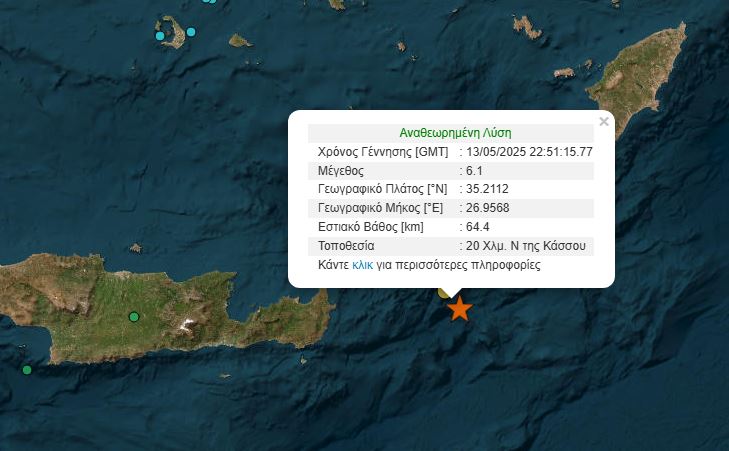

A significant 6.1 Richter earthquake struck around 2 am on Wednesday in the sea area 20 kilometers south-southwest of Kasos, east of Crete, at a focal depth of 64.4 kilometers, as reported by the Geodynamic Institute of the National Observatory of Athens. The quake caused notable disturbance, particularly felt in Crete and Rhodes, prompting a precautionary tsunami warning from emergency services.
As of now, there have been no reports of injuries or serious material damage. Tremors from the quake were felt as far away as Israel and southwestern Turkey. People in Egypt also felt the quake.
Geology professor and president of OASP, Efthymios Lekkas, provided reassurance in an interview with ERT, stating, “The focal depth of 60 kilometers is the defining characteristic of this event. It reached Kasos and Karpathos, and notably affected Crete. Initial reports from residents indicate no significant impacts, though the situation is still developing.”
Lekkas emphasized, “At this depth, earthquakes typically occur as singular events, without extensive pre- or post-seismic sequences.”
He clarified, “This earthquake occurred along the Greek arc, where the European and African plates converge. It was strongly felt across Crete, Rhodes, Kos, and the southeastern Aegean.”
Addressing concerns about connections to recent earthquakes in Santorini and Turkey, Lekkas affirmed, “There is absolutely no correlation with the seismic activity in Santorini or Turkey. The geological contexts are distinctly different. This event is situated on the Greek arc, whereas Santorini experiences volcanic activity, and Turkey’s earthquakes are along the Anatolian fault. Given the depth of 60 kilometers, we do not expect a significant aftershock sequence or consider it a precursor to a larger earthquake.”
A 6.2-magnitude earthquake that struck in late April in Istanbul, injuring at least 150 people, has reignited fears of a far more catastrophic event.
The North Anatolian Fault — one of the most active and dangerous in the world — runs just south of Istanbul. The segment near the city has not ruptured since the devastating 1999 İzmit earthquake, which killed over 17,000 people.
In early 2025, a series of moderate earthquakes hit Santorini in the central Aegean, causing fears of a larger quake.
The undersea rocks -sometimes only minutes apart- have led thousands of local resident to flee Santorini, one of Greece’s most popular tourist destinations, as well as the nearby islands of Amorgos, Ios and Anafi.
Between January 26 and February 13, more than 18,400 quakes, mainly of a low magnitude, were recorded off islands in the Cyclades archipelago, according to the University of Athens seismology laboratory.
Greece is located on several fault lines and is sporadically hit by earthquakes.
